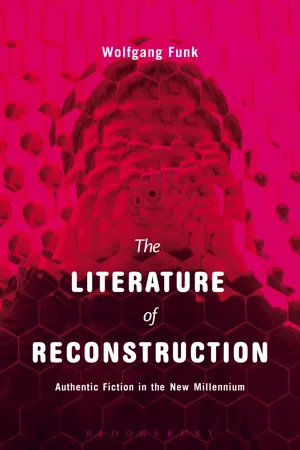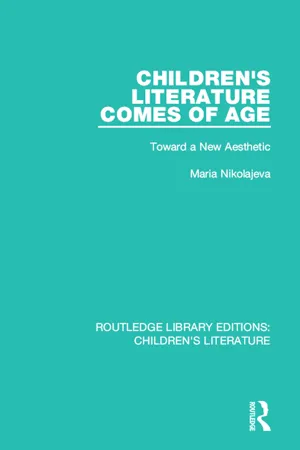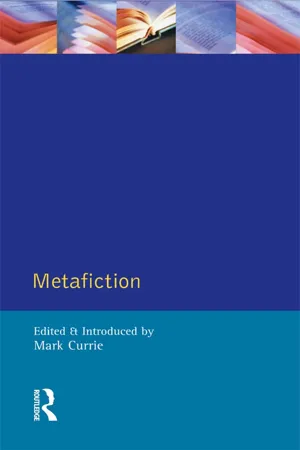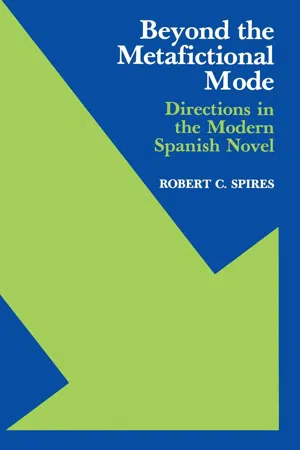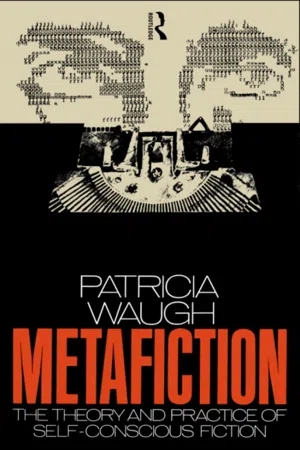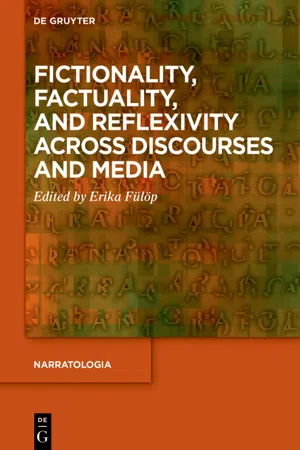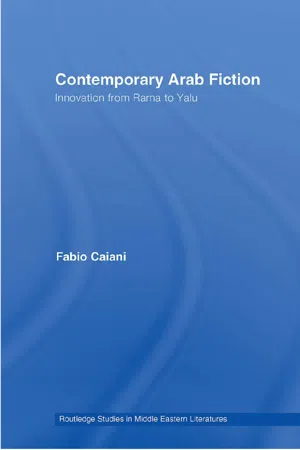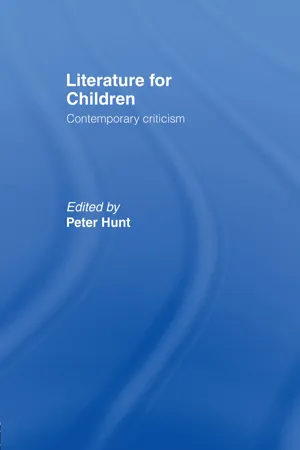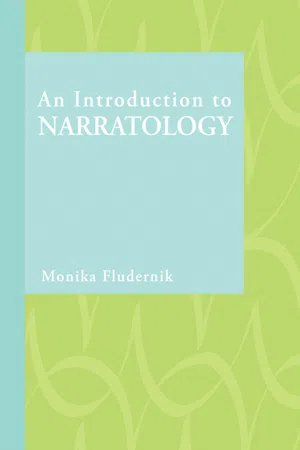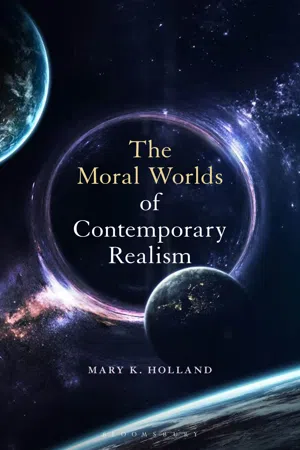Literature
Metafiction
Metafiction is a literary technique that draws attention to the artificiality of the narrative, often by breaking the fourth wall or self-consciously referencing its own status as a work of fiction. It blurs the line between fiction and reality, inviting readers to consider the nature of storytelling and the role of the author. Metafiction can be found in various literary genres and styles.
Written by Perlego with AI-assistance
Related key terms
11 Key excerpts on "Metafiction"
- eBook - ePub
The Literature of Reconstruction
Authentic Fiction in the New Millennium
- Wolfgang Funk(Author)
- 2015(Publication Date)
- Bloomsbury Academic(Publisher)
These include John Barth’s ‘literature of exhaustion’ (1972), Fletcher and Bradbury’s ‘introverted novel’ (1978), Steven Kellman’s ‘self-begetting novel’ (1980), Michael Boyd’s ‘ reflexive novel ’ (1983) alongside later attempts such as Mark Currie’s term ‘theoretical fiction’ (1998: 52). The label that would eventually stick is ‘Metafiction’, a term originating with William H. Gass, who in Fiction and the Figures of Life describes as such a variety of novel ‘in which the forms of fiction serve as the material upon which further forms can be imposed’ (1970: 25). Two formative studies, Patricia Waugh’s Metafiction: The Theory and Practice of Self-Conscious Fiction and Linda Hutcheon’s Narcissistic Narrative: The Metafictional Paradox (both 1984), have contributed in no small measure to the fact that discussions of literary self-reference in the second half of the twentieth century are usually conducted under the heading of Metafiction. Waugh distils previous notions into what can be taken as the standard definition for this particular form of fictional discourse: Metafiction is, she suggests, ‘a term given to fictional writing which self-consciously and systematically draws attention to its status as an artefact in order to pose questions about the relationship between fiction and reality’ (1984: 2). Waugh emphasizes the twofold thrust of such writing. First, it constitutes in and through itself an aesthetic and critical evaluation of the theoretical and practical conditions and limitations of its own literariness. By doing so, it also urges readers to gauge their own position with regard to reality as an experience and their own self-narrativization of this experienced reality. Metafictional texts therefore ‘also explore the possible fictionality of the world outside the literary text’ (2) and offer ‘extremely accurate models for understanding the contemporary experience of the world as a construction, an artifice, a web of interdependent semiotic systems’ (9) - eBook - ePub
Children's Literature Comes of Age
Toward a New Aesthetic
- Maria Nikolajeva(Author)
- 2015(Publication Date)
- Routledge(Publisher)
Sometimes we discover such statements in literary analyses which are reminiscent of medical journals in that they treat figures in novels as if they were indeed patients (“Rusky goes through a psychic crisis with the following symptoms …”). Many a critic today seriously questions reading fiction mimetically, as if there were a reality behind the words. In mimetic reading the first-person narrator in a novel is identified with the writer. Realism as a literary device is confused with credibility or verisimilitude. However, unlike documentary or journalism, fiction is not a direct reflection of reality but an artistic transformation of it. As various reception studies have pointed out, in any work of art there is a relationship between the author, the text and the reader. The notions of the implied writer and the implied reader, the narrator and the narratee are of general significance for our understanding of the nature of children’s literature. More and more children’s books consciously pose questions about the relationship between the writer, his creations and his readers. Such texts have been named Metafiction, books about books and the writing of books, books which somehow explain themselves, investigating the essence of writing by describing the creative process itself. The diversity of Metafictional levels we can observe in literature today is a feature of its postmodern phase, although it can be found in texts from much earlier periods. Still, it is only recently that literary critics have both become aware of this fascinating device and started examining it. A study by Patricia Waugh, Metafiction. The Theory and Practice of Self-conscious Fiction, is wholly devoted to this subject. 1 Patricia Waugh defines Metafiction as “fictional writing which selfconsciously and systematically draws attention to its status as an artifact in order to pose questions about the relationship between fiction and reality” (p. 2) - eBook - ePub
- Mark Currie(Author)
- 2014(Publication Date)
- Routledge(Publisher)
Metafiction explicitly lays bare the conventions of realism; it does not ignore or abandon them. Very often realistic conventions supply the ‘control’ in Metafictional texts, the norm of background against which the experimental strategies can foreground themselves. More obviously, of course, this allows for a stable level of readerly familiarity, without which the ensuing dislocations might be either totally meaningless or so outside the normal modes of literary or non-literary communication that they cannot be committed to memory (the problem, already discussed, of much contemporary ‘aleatory’ writing). Metafiction, then, does not abandon ‘the real world’ for the narcissistic pleasures of the imagination. What it does is to re-examine the conventions of realism in order to discover – through its own self-reflection – a fictional form that is culturally relevant and comprehensible to contemporary readers. In showing us how literary fiction creates its imaginary worlds, Metafiction helps us to understand how the reality we live day by day is similarly constructed, similarly ‘written’.‘Metafiction’ is thus an elastic term which covers a wide range of fictions. There are those novels at one end of the spectrum which take fictionality as a theme to be explored (and in this sense would include the ‘self-begetting novel’), as in the work of Iris Murdoch or Jerzy Kosinski, whose formal self-consciousness is limited. At the centre of this spectrum are those texts that manifest the symptoms of formal and ontological insecurity but allow their deconstructions to be finally recontextualized or ‘naturalized’ and given a total interpretation (which constitute, therefore, a ‘new realism’), as in the work of John Fowles or E.L. Doctorow. Finally, at the furthest extreme (which would include ‘fabulation’) can be placed those fictions that, in rejecting realism more thoroughly, posit the world as a fabrication of competing semiotic systems which never correspond to material conditions, as in the work of Gilbert Sorrentino, Raymond Federman or Christine Brooke-Rose. - eBook - ePub
Studies in Romance Languages
Directions in the Modern Spanish Novel
- Robert C. Spires(Author)
- 2021(Publication Date)
- The University Press of Kentucky(Publisher)
Yet for my own purposes as a teacher and critic I have found that none of the studies is quite adequate to the task of drawing the limits to what reasonably should and should not be labeled Metafiction. Alter, for example, says that a self-conscious novel deliberately exposes the artifice of fiction, which is not to be confused with an elaborately artful novel where the artifice may be prominent. Such a differentiation might be useful if some formula were provided for deciding how “prominent” the artifice must be before it is considered “deliberately exposed.” Although Scholes’s approach is patterned on formalist-structuralist concepts, his definition of Metafiction as a work assimilating all the perspectives of criticism into the process itself of fiction is, if anything, even more open-ended than that of Alter. And Pérez Firmat’s “narration-gloss of the narration” formula would seen to allow every novel with an intrusive narrator to qualify as Metafiction, while the reliance on allegory for his “narrative Metafiction” category threatens to make the term all-inclusive. Even Hutcheon’s diegetic versus linguistic categories, which are broken down into overt and covert subcategories, tends to expand the application excessively. Finally, Christensen hardly leads us beyond the now standard definition of Metafiction as a novel about itself, a definition that is fine in the most obvious examples where a character or narrator discourses about the nature of novels in general, but inadequate when it is a question of deciding if more subtle and complex techniques qualify as novelistic self-commentary. As a step in the direction of plotting where the limits might be drawn, I have adopted a linguistically grounded approach focused on the concept of modes - eBook - ePub
Metafiction
The Theory and Practice of Self-Conscious Fiction
- Patricia Waugh(Author)
- 2002(Publication Date)
- Routledge(Publisher)
Metafiction explicitly lays bare the conventions of realism; it does not ignore or abandon them. Very often realistic conventions supply the ‘control’ in Metafictional texts, the norm or background against which the experimental strategies can foreground themselves. More obviously, of course, this allows for a stable level of readerly familiarity, without which the ensuing dislocations might be either totally meaningless or so outside the normal modes of literary or non-literary communication that they cannot be committed to memory (the problem, already discussed, of much contemporary ‘aleatory’ writing). Metafiction, then, does not abandon ‘the real world’ for the narcissistic pleasures of the imagination. What it does is to re-examine the conventions of realism in order to discover – through its own self-reflection – a fictional form that is culturally relevant and comprehensible to contemporary readers. In showing us how literary fiction creates its imaginary worlds, Metafiction helps us to understand how the reality we live day by day is similarly constructed, similarly ‘written’.‘Metafiction’ is thus an elastic term which covers a wide range of fictions. There are those novels at one end of the spectrum which take fictionality as a theme to be explored (and in this sense would include the ‘self-begetting novel’), as in the work of Iris Murdoch or Jerzy Kosinski, whose formal self-consciousness is limited. At the centre of this spectrum are those texts that manifest the symptoms of formal and ontological insecurity but allow their deconstructions to be finally recontextualized or ‘naturalized’ and given a total interpretation (which constitute, therefore, a ‘new realism’), as in the work of John Fowles or E. L. Doctorow. Finally, at the furthest extreme (which would include ‘fabulation’) can be placed those fictions that, in rejecting realism more thoroughly, posit the world as a fabrication of competing semiotic systems which never correspond to material conditions, as in the work of Gilbert Sorrentino, Raymond Federman or Christine Brooke-Rose. - Erika Fülöp, Erika Fülöp(Authors)
- 2021(Publication Date)
- De Gruyter(Publisher)
referential status. Contrary to fictional utterances, which do not refer (or refer to a fictional world), Metafictional statements are serious utterances about the text, its fictionality, or its readers.The implication is that Metafiction, according to Genette and Ryan, triggers a factual – instead of a fictional – mode of reading. It does not invite us to imagine a fictional world, but describes this world from the outside, framing it as the product of writing techniques and reading processes. Hence, this is the paradox of Metafiction: it stresses the fictionality of the text but does so by tacitly excluding itself from this fictionality. Given this, we must not be surprised that many (if not most) commentators on Metafictional texts attribute a truth value to mises en abyme, which they suppose, sometimes uncritically, to reveal something about some aspect of the text. A frequent concern of theoreticians studying Metafiction is the risk of proliferation: the tendency of overeager readers to see Metafiction everywhere – say, in every mirror, labyrinth, or character reading a book that may happen to be mentioned in a novel. Some, among them Lucien Dällenbach (1977/1986) and Bernard Magné (1986) , have devised criteria in order to preclude over-interpretation by limiting the Metafictional hypotheses to cases where reflexivity clearly contributes to a textual strategy. (One may think that their proposals aim to discipline the field in order to assuage the doubts conservative critics may entertain towards Metafiction as such.) But this concern should not hide a more insidious trap facing critical discourse about Metafiction: not the tendency to overestimate the frequency of self-reflexive devices or patterns, but the inclination to see in these devices and patterns truths about the text. Strangely enough, many a critic’s caution seems to be forgotten when it comes to self-reflexivity, as though the latter demanded – and obtained – an unconditional trust in its reliability, hence the not infrequent comments that describe mises en abyme and other Metafictional devices as instructions (modes d’emploi) for the readers; see, for instance, Bal (1978 , 126) and Dällenbach (1986- eBook - ePub
Contemporary Arab Fiction
Innovation from Rama to Yalu
- Fabio Caiani(Author)
- 2007(Publication Date)
- Routledge(Publisher)
5Metafiction
This chapter will analyse the extent to which the novels under scrutiny here deal with fiction itself (and more generally with the acts of writing and reading), highlighting the purpose and effects of such a phenomenon.This autoreferential element (Metafiction) is linked to the foregoing analysis of both polyphony and intertextuality through the figure of the author. The author disappears, or at least weakens his position, in an ideal polyphonic novel where his point of view seems to be absent or is made equal to that of various other characters. In addition, according to Barthes, the intertextual nature of the novel confines the author to the mere function of organizer of somebody else’s texts.1 With Metafictional experiments, the figure of the author is to be clearly reinstalled within the text. Using the logic of paradox, Brian McHale explains how modernist writers in the West tried to conceal the author in their texts through different devices, only to have their readers increasingly thinking of ‘the strategist’ behind such devices (such as the dialogue-dominated text, free indirect discourse, first person narration, the interior monologue, the montage text).2 On the other hand, according to McHale, postmodernist writers indulging in self-advertisement in their texts achieve self-effacement more successfully: again, Barthes claims that the author is not merely absent from his or her text (as the modernists wished it to be), he or she is simply dead (McHale 1987: 199–200).3As noted in the previous chapter, one of the effects of introducing extracts from other texts in fiction is to increase the reader’s awareness of the novel as an artefact: the readers are invited to reflect on literature itself rather than the external world which it is supposed to portray. This effect is also and more directly achieved by other Metafictional devices such as more or less explicit discourses on fiction which are included in the novel itself. There are two main methods by which the novelists under discussion here introduce this self-reflexive element into their novels: - eBook - ePub
Contested Transparencies, Social Movements and the Public Sphere
Multi-Disciplinary Perspectives
- Stefan Berger, Dimitrij Owetschkin, Stefan Berger, Dimitrij Owetschkin(Authors)
- 2019(Publication Date)
- Palgrave Macmillan(Publisher)
The provisional nature of fictive language allows it both its imaginative freedom and its claim to truth”. 76 Such a text thus playfully directs the readers’ attention to language and, in turn, to the question of meaning and the very impossibility of fixing it. In that sense and in spite of its alleged autonomy, it does represent the world, but, as Roland Barthes has it, it “represents it as a question – never, finally, as an answer”. 77 Thus, Metafiction, arguably by means of a complex interplay of transparency and intransparency, does not resort to a mimetic mode of representation, since this, to put it in Walsh’s words, “is not conceived of as the primary vehicle of [the text’s] engagement with the world”. 78 At the very same time, however, it invites the reader to re-establish just this relationship between text and world, which is thus simultaneously weakened and strengthened. 79 Metafiction generally, as Mark Currie has noted, almost inherently makes the reader an active participant in the process of the constitution of meaning. In order to do so, it frequently makes transparent not only the act of narration but also that of reading, incorporating into the text “a kind of surrogate author grappling with his ability as a storyteller and with the ability of words to communicate […] experience” as well as “a surrogate reader trying, as protagonist […] to make sense of events and to interpret [their] significance in a manner analogous to that of the external reader”. 80 Metafiction thus “internalizes the relationship between authors and readers, fiction and criticism, art and life” 81 and can thus be seen as a privileged vantage point from which to reflect on a number of further problems inherent to fiction in general: the relationship between literature and external reality, text and world, between perception and representation, between language and reality, between history and story, between text and reader - eBook - ePub
- Peter Hunt(Author)
- 2003(Publication Date)
- Routledge(Publisher)
2
Criticism: the state of the art
The three essays in this section illustrate the application of current critical techniques and terminologies to aspects of children’s literature. They have in common a link with the Modern Language Association of America: Geoff Moss and Lissa Paul delivered versions of their essays at the MLA Convention in New Orleans in 1988, while Sarah Gilead’s work was published in PMLA. Otherwise, their approaches and tones of voice are very different: Moss comes closest to the accessible yet scholarly attitude that is becoming characteristic of the mainstream, synthesizing children’s literature criticism; Paul’s discourse, as befits her material, is experimental; while Gilead’s selection of language is characteristic of the dialect of critical theory (and as such, perhaps less immediately approachable by the layperson). Together, however, they give a good impression of the range, diversity and essential commonality of contemporary criticism.‘ Metafiction is a term given to fictional writing which self- consciously and systematically draws attention to its status as an artefact in order to pose questions about the relationship between fiction and reality’ (Waugh 1984:2). As such, it might be supposed that we are dealing with a sophisticated form quite alien to children’s literature. But the reverse is true; children— developing readers—live in a world which is far more conscious of and ambivalent about the relationship between fiction and reality than the world of the skilled reader, and children’s writers have responded to this, perhaps more than is generally acknowledged. As Anita Moss suggests:Many novelists have been acutely concerned with the process of creating narrative and with the narrative forms of ordinary life which are embedded throughout fiction. The nature of narrative itself often becomes the real concern in novels and stories. Why characters tell stories and how they tell them, as well as to whom, become major themes in Paula Fox’s How Many Miles to Babylon? (1967), Natalie Babbitt’s Knee-Knock Rise (1971), Charles Dickens’ A Holiday Romance (1868), and E.Nesbit’s The Story of the Treasure Seekers (1899). To a greater or lesser extent all of these books may be considered as‘Metafictions’, works in which the imagined process by which the story is created becomes a central focus of the book. This Metafictional quality is implicit in the first two works and explicit in the last two, as both A Holiday Romance and The Story of the Treasure Seekers - eBook - ePub
- Monika Fludernik(Author)
- 2009(Publication Date)
- Routledge(Publisher)
fictum, and that truth in the historical or practical sense of the word can only be generated in context by comparison with other information. The fact that objects, people and places actually exist cannot be adduced from the text alone but must be supported by evidence from the context and other sources of information.Metafiction and metanarrationAt this point it might be helpful to clarify two concepts that are often used in connection with postmodern texts and are frequently regarded as signs of anti-realism: metanarration and Metafiction. We should note, to begin with, that these terms are often treated as identical in meaning, particularly in the English-speaking world. Metanarrative narratorial comments are widely seen as evidence of fictionality and so they are often considered to be instances of Metafictionality. Such an equivalence cannot be taken for granted, however. On the contrary, metanarrative comments can considerably strengthen the illusionistic effect of a realistic narrative, as Ansgar Nünning has pointed out (Nünning 2004).Metanarrative narratorial comments are to be found in texts dating from long before the twentieth century; indeed, they already existed in the Middle Ages. In conversational narrative, the so-called abstract can be counted as a metanarrative comment on the part of the storyteller, for example: ‘Have I already told you about the time when the parrot came and perched on my head?’ Metanarrative statements fulfil a wide variety of functions, most of them hardly noticeable as the phrases are so short, like the verb ‘told’ in the example above. Many purported metanarrative sections of narrative are actually metadiscursive (Fludernik 2003b, Engler 2004). They help readers to orientate themselves on the discourse level (‘as we saw above’ and ‘as we shall see in the next chapter’) and to shift their attention from one location or group of people to another more easily (‘We shall therefore see a little after our hero’, Joseph Andrews - eBook - ePub
- Mary K. Holland(Author)
- 2020(Publication Date)
- Bloomsbury Academic(Publisher)
Ironically, or fittingly, Jameson’s conclusion about the destruction of realism repeats in new terms Wallace’s n ow-famous lament about the “toothlessness” of irony and the “Armageddon” of postmodern Metafiction from his 1991 interview. That proclamation itself revised Barth’s assessment of the “Literature of Exhaustion” in 1967. In his essay, Barth argued that realism as a representational mode had become so ineffective that it needed to be revived from within, in the self-reflexive moves of 1960s Metafiction. Declaring such Metafiction itself exhausted thirty years later, Wallace called for, and began to construct, a revitalization of realism through reimagining Metafiction, which I have demonstrated here and elsewhere. When Jameson declares the death of realism a little more than twenty years after Wallace began resuscitating it through Metafiction, it seems reasonable to ask what Metafiction’s role might have been in this putative death, and whether attempts by Wallace (and by those who influenced him, and whom he influenced) to use Metafiction to revive, rather than kill, realism, were a total failure. I argue that they were not.Jameson concludes his study of “The Antinomies of Realism” with the depressing claim that the dissolution of realism has left in its wake a flood of what he calls “existential novels,” which lack authentic temporality and subjectivity, allow no moral judgment, obscure the painful gap between subject and object through linguistic tricks, and feed our late-capitalist desire for easily consumed, affect-driven content that reassures our senses of self and of “endless possibility.” Such is, he claims, the state of popular fiction. Literary fiction, or “the postmodern and its narrative production” as he terms it, is no more admirable and arguably no more lifelike. Using Alexander Kluge’s tales as his example of “what happens to both narrativity and affect after the end of their brief union” (188), Jameson characterizes post-realism literary fiction as having no author, expressing no affect, and making no distinction between the fictive and the non-fictive, so that it “also testifies to the disappearance of ‘fiction’ as such, as a meaningful (narrative) category” (189). Since I (and others) read Wallace’s quite challenging literary fiction as doing exactly the opposite—invoking an author, provoking and representing affect, and drawing a distinction between fiction and nonfiction precisely in order to preserve our sense of a real world,42
Index pages curate the most relevant extracts from our library of academic textbooks. They’ve been created using an in-house natural language model (NLM), each adding context and meaning to key research topics.
